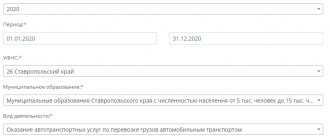Organizations, when calculating depreciation of fixed assets, can use both the linear method of calculating depreciation and non-linear methods. These include the method of writing off value in proportion to the volume of production (work) or the productive method of calculating depreciation .
The procedure for calculating depreciation is prescribed in the order on the accounting policy of the organization. Depreciation starts from the next month after the fixed asset is put into operation and stops in the month of complete write-off or disposal of the object.
When is the method of writing off cost in proportion to the volume of products (works, services) applied?
The company has the right to choose the method of writing off the cost in proportion to the volume of production (SPO) at its discretion from the permitted methods of calculating depreciation.
But such an opportunity exists only in accounting. In the Tax Code of the Russian Federation everything is different. IMPORTANT! In accounting, there are 4 methods of calculating depreciation, listed in clause 18 of PBU “Accounting for fixed assets” (approved by order of the Ministry of Finance of Russia dated March 30, 2001 No. 26n): 1 linear and 3 non-linear. There are only 2 methods in the Tax Code of the Russian Federation - linear and nonlinear (Article 259).
SPO belongs to the group of “accounting” non-linear methods, however, it has significant differences with “tax” non-linear depreciation. They are related to the peculiarities of the methodology for calculating the amount of depreciation in the event of an STR:
- to calculate depreciation, it is necessary to have information about the expected volume of products (work, services) during the entire useful life of the property;
- depreciation for the billing period directly depends on the volume of products (works, services) produced using this type of property.
IMPORTANT! From 2022, PBU 6/01 will no longer be in force. It will be replaced by FSBU 6/2020. The provisions of the new FSBU can be applied earlier by enshrining such norms in the accounting policies of the enterprise.
Find out how to calculate depreciation, taking into account the provisions of FSBU 6/2020, in ConsultantPlus. To do everything correctly, get trial access to the system and go to the Ready solution. It's free.
With the “tax” non-linear method, the amount of depreciation is not calculated for a separate type of depreciable property, but depends on the total balance of the depreciation group and established by Art. 259.2 of the Tax Code of the Russian Federation, depreciation standards.
When choosing a depreciation method, priority may be given to SPO in the case when:
- machines, equipment and other property are used intensively for the production of certain types of products (performance of work, provision of services);
- it is possible to definitely establish a connection between the depreciation of property and the volume of products produced (work or service performed).
In any case, the approach to choosing a depreciation method should be carried out in a balanced and justified manner, with the benefits of such a write-off of property value compared with the level of calculation and accounting costs that arise. We'll talk about this in the next section.
The material “Which method to choose for calculating depreciation in tax accounting?” will help you decide on the “tax” depreciation method.
Example 1
A vehicle with a carrying capacity of more than 2 tons with an estimated mileage of 400 thousand km was purchased. Cost 1.5 million rubles. In the reporting year, the mileage is 5 thousand km. Determine the annual amount of depreciation charges using the write-off method in proportion to the volume of production.
Thus, this year the cost of production should include 18,750 rubles. For accounting purposes, depreciation must be calculated on a monthly basis.
How to evaluate the correctness of the chosen depreciation method?
To assess the correctness of the choice of depreciation method, it is necessary to calculate the amount of monthly depreciation for different methods of its calculation and compare the information obtained with the “depreciation policy” of management - its intentions regarding the write-off of property value (the need for its accelerated write-off, the need to evenly transfer the value of property to the cost of production and etc.).
SPO is not a commonly used method of calculating depreciation and is not suitable for all companies. It can be completely replaced by the simplest method to use - linear, in which:
- there is no need to regularly recalculate the amount of depreciation (it is constant from period to period, unless the property is subject to modernization, reconstruction or additional equipment that affects the increase in its value and useful life);
- there is a possibility of convergence between accounting and financial accounting in terms of depreciation charges;
- the change in residual value and accumulated depreciation occurs evenly.
The use of the linear method instead of SPO is justified if the company is expected to receive the same benefit (income) from this type of property throughout its entire service life, and its usefulness decreases gradually (as it wears out).
If we compare SPO with another accounting “depreciation” method - based on the sum of the numbers of years of useful use, then we must proceed from the following features of this method:
- the amount of depreciation is maximum in the first year of operation of the operating system and decreases gradually towards the end of its useful life;
- Depreciation is calculated over the entire useful life.
To compare this method with SPO, it is necessary to compare the calculated depreciation amounts for each period and choose the method in which you can write off the value of property faster - if such a task is provided for in the company’s development strategy.
Similarly, based on calculation, analysis and comparison, the most acceptable and rational method of calculating depreciation is selected between SPO and the reducing balance method - another “accounting” non-linear method.
Study the methods of calculating depreciation using the materials on our website:
- “Formula and example of the reducing balance method of depreciation”;
- “How to correctly apply the cumulative depreciation method?”.
Depreciation and examples of its calculation
Each company has the opportunity to take into account costs that are directly related to the purchase of certain categories of assets using the depreciation method. It is in this way that expenses incurred by the company are taken into account when calculating taxes.
Due to the fact that the actual amount of depreciation has a direct impact on the amount of the company’s income tax, the importance of correct calculation is an important task for the accountant.
Let us consider in practice examples of calculating depreciation of property belonging to the group of fixed assets.
Methods for calculating depreciation
All the main points related to the calculation of depreciation are reflected in PBU 6/01 “Accounting for fixed assets”. This legal document reveals techniques that allow wear to be determined. These include:
- Linear;
- Declining balance;
- Write-offs are proportional to the volume of products produced;
- Write-offs based on the sum of numbers of SPI years.
It is important for an accountant to know that these methods are available for use strictly in accounting for the purposes of the organization’s accounting. As for tax accounting, the law establishes the existence of only 2 permitted methods - non-linear and linear.
Let us consider in more detail each proposed method of calculation in a practical situation.
Example of depreciation using the straight-line method
This technique is distinguished by its simplicity. That is why it has gained the greatest popularity among companies. The meaning of the methodology is that throughout the SPI, depreciation should be accrued in equal amounts using the formula:
A = Article OSprimary. * The depreciation rate, in which case the depreciation rate will be calculated as follows:
Am-tion rate = 1 / Number of months of SPI.
Example.
Imperia LLC for 170 rubles. weaving equipment belonging to the OF group was purchased on 03/20/17. Based on the technical documentation, the SPI was set at 84 months.
Let us determine how the amount of deductions for weaving equipment will be calculated:
A = 170 tr. * (1/84*100%) = 2.024 tr.
Therefore, starting from April 1, 2021, the company will take into account depreciation in the amount of 2,024 tr. for 7 years.
The linear method is reasonably considered the most popular due to its ease of use in practice.
Depreciation: examples of calculation using the reducing balance method
Expensive computer equipment belonging to the OS category was purchased, costing 230 thousand rubles. In this case, the useful life will be 8 years or 84 months.
The company's internal documentation determined that depreciation would be calculated using the reducing balance method. The company's management assumes that the maximum income from the operation of this equipment will be received in the first years after purchase.
As a result, Avangard decided to use an acceleration coefficient in the calculations, the value of which was determined to be 1.6%.
- Let's calculate the depreciation rate for 1 year:
NA = 100% / 8 years = 12.5%
- The annual depreciation rate taking into account the acceleration factor will be determined as follows:
NA = 12.5% * 1.6% = 20%.
- The amount of depreciation charges for the first year after commissioning of the equipment is calculated:
A = 230 tr. * 20% = 46 tr, that is, it will depreciate monthly computer equipment in the amount of 3,833 tr. (46 TR / 12 months).
A feature of the practical use of this method is the ability to take into account the specific intensity of equipment use.
- The amount of depreciation charges for the second year after commissioning of the equipment is determined:
A = (230 tr. – 46 tr.) * 20% = 36.8 tr. per year or 3,067 tr. per month (36.8 tr. / 12 months).
- The amount of depreciation charges for the third year after commissioning of the equipment is calculated:
A = (230 tr. – 46 tr. – 36.8 tr.) * 20% = 29.44 tr. per year or 2,453 tr. monthly (29.44 tr. / 12 months).
Depreciation: example of calculation using the write-off method in proportion to the volume of products produced
The Tandem organization purchased a machine for producing components for 780 rubles. In this case, the SPI is 5 years, that is, 60 months. Acceptance for registration was made in March 2021.
Based on the technical passport, the company’s management assumes that this product will be able to produce 70,000 units of components over the entire SPI.
At the same time, 1,500 units were actually produced in April, and 1,800 units of products were produced in May. Let's determine the amount of depreciation in April and May 2021.
Aapr = 780 tr. / 70,000 units * 1,500 units. = 16.714 tr.;
Amai = 780 tr. / 70,000 units * 1,800 units. = 20.057 tr..
This method also allows you to take into account the intensity of equipment use, without taking into account those months when production is idle. However, in cases where the lack of orders is regular, the use of this technique is inappropriate.
Depreciation of fixed assets: example of calculation using the write-off method based on the sum of the numbers of years of SPI
The company purchased a vehicle painting booth for 460 rubles. and SPI 6 years or 72 months. Let's calculate the amount of wear and tear in the first three years of use of an asset.
- Am-tion rate = 6/(1+2+3+4+5+6) * 100% = 28.57%;
Agodovaya = 460 tr. * 28.57% = 131.422 tr., that is 10.952 tr. monthly.
- Am-tion rate = 5/(1+2+3+4+5+6) * 100% = 23.81%;
Agodovaya = 460 tr. * 23.81% = 109.526 tr., that is, 9.127 tr. monthly.
- Am-tion rate = 4/(1+2+3+4+5+6) * 100% = 19.05%;
Agodovaya = 460 tr. * 19.05% = 87.630 tr., that is 7.303 tr. monthly.
Each company, based on its own needs and specifics of activity, individually determines the methods for calculating depreciation.
Source: https://buh-spravka.ru/buhgalterskij-uchet/amortizaciya-iznos-os/primer-rascheta-amortizacii.html
Method of writing off cost in proportion to production volume: calculation example
Let's look at an example of how to calculate depreciation using the SPO method.
Example
The company produces metal components for production equipment according to customer requests. For these purposes, in February 2021, a lathe with electronic numerical control was purchased and put into operation at an initial cost of RUB 3,000,000.
Taking into account the technical resource and productivity of this machine, it is planned to produce 300,000 units of products over its entire useful life.
In March and April 2021, 2,500 and 3,200 units were produced on this machine. products, respectively, and in May the machine was idle due to the lack of requests from the customer for this type of product. Let us determine the amount of depreciation in the indicated months:
In March: RUB 3,000,000. / 300,000 units × 2,500 units = 25,000 rub.
In April: RUB 3,000,000. / 300,000 units × 3,200 units = 32,000 rub.
In May: RUB 3,000,000. / 300,000 units × 0 units = 0 rub.
The example shows that with the SPO method, the write-off of the value of property can be accelerated (if the property is used in an intensive, multi-shift mode) or may not be carried out at all (if there are no orders, demand for this type of product has fallen, etc.). In a situation of persistent instability of orders, it becomes unprofitable to use open source software.
Check whether you have calculated depreciation correctly in tax accounting using the Ready-made solution from ConsultantPlus. If you do not have access to the K+ system, get a trial online access for free.
The impact of legislative changes on the choice of depreciation method
Legislators have simplified certain aspects of calculating and calculating depreciation of property for companies that have the right to conduct accounting and prepare reports in a simplified form (Order of the Ministry of Finance of the Russian Federation dated May 16, 2016 No. 64n, which entered into force on June 20, 2016).
IMPORTANT! Small enterprises and non-profit companies with annual revenue of no more than 3 million rubles have the right to use simplified methods of accounting (including simplified accounting). (with the exception of certain categories of non-profit organizations), as well as companies that are residents of Skolkovo (letter of the Ministry of Finance of Russia dated December 27, 2013 No. 07-01-06/57795).
From June 20, 2016, these companies have the right to:
- do not include in the initial cost of fixed assets the costs associated with their acquisition (valuing the property at the price of the supplier (including installation)) - they can be immediately included in the costs of ordinary activities in full during the period of their implementation;
- Depreciation of fixed assets is calculated once a year on December 31 (or during the year at the choice of the company).
For more information about the innovations of Law No. 64n, see the material “Calculation of depreciation once a year and other innovations for those who have access to simplified accounting .
These innovations make it possible to quickly write off the cost of property (including using the SPO method), since part of the costs is included in expenses immediately, without including them in the initial cost.
The legally mandated ability to charge depreciation once a year reduces accounting calculations, although more frequent calculations may be necessary for internal financial reporting and property tax purposes.
These innovations do not have a direct impact on the efficiency of using a particular depreciation method, although they help reduce depreciation amounts and the frequency of their calculation. And to select SPO as one of the possible methods of writing off the value of property, an assessment, preliminary calculations and justification are required.
How to avoid differences in accounting and tax accounting when writing off the value of property, see the material “A way to take into account fixed assets worth from 40 to 100 thousand rubles in tax accounting, avoiding differences with accounting .








